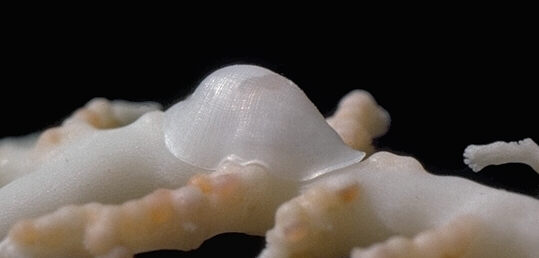Memory
We are a
crystal memory in a Magic Sea

.
The flow of communications between each atom, every cell, every
creature, leaves a wake. For corals and many other animals, the wake takes the form of a
skeleton, made of molecules of calcium carbonate. For plants, the wake is solidified with
cellulose. The skeleton is a crystal memory, revealing years of perceptions, memories and
responses.
Perception-memory-response is a flow of communications through the
focus of a being. Perceptions and memories are mirror images of each other, reflected flows of streaming information, selectively regulating the process of becoming.
These streams not only create a skeletal wake, they project a bow wave of momentum.
The wake and the bow wave of the streams of communications establish
a trajectory the participants must follow. These trajectories are the visible boundaries
of life, the interfaces of perception, memory and response we perceive as living entities.
Before the evolution of mind, memory existed as momentum and
conservation of energy. The trajectory of an arrow in flight, for example, carries a "memory" of the bow and even of the archer's aim.
In living systems, memory is communication momentum. At each level -
molecular, cellular, multicellular - the composite beings expect the existing movement of
energy and information to follow a pre-established pattern. The pattern of expectation is
an accumulation of all of the past experiences of that being - about 3.6 billion years of
experiences.

Memory, A dynamic position
Memory, like perception, threads through a living
system, balanced on the shifts and movements in the flow of information.
The small crab hiding on a
sea fan is an accumulated set of conditions and communications threading through the
entire web of relationships between the sea fan, the crab and its predators. All members of the association rely on the existing structural relationships to assess the ongoing stream of perceptions and responses.
Our memories are also based on structural relationships. If you can remember the image, now that it is
off screen, it is because the perception was encoded in a specific set of molecular bonds
within your neurons. Your memory is a structural event, a structure created by and with
intercommunications threading through the entire web of relationships existing between all the layers of your being, from atoms to as far as your perception and your imagination can reach.
Just as the crab has a dynamic structure and position
on the sea fan, the molecules of memory have a dynamic structure and occupy a special
position in the web of communications of your brain.
The pattern of information flow, regulated by the
atomic bonds of these molecules, changes in response to your perceptions. By repetition or
by importance, the new molecular condition becomes increasingly permanent. New protein
structures, imprinted with former perceptions, crystalize within the cytoplasm of the neuron, attached like threads to the mysterious golgi apparatus. The threads of memory get longer and more numerous as we encode more information. Each thread holds fast to the skeletal protein web of your neurons like tiny crabs who have found just
the right place in life.
Shaping Memory

Our memories are personal, intimate, often hidden even
from ourselves.
Each experience shapes the molecular web of
communications and this, in turn, shapes our physical form. A good example of this is a
tiny sea snail who lives on the porcelain coral Stylaster in the deep water of China
Straits, in Papua New Guinea. It moves about at night to graze, but returns to exactly the
same place on the coral each morning. Its shell molds itself perfectly to the coral because
the snail holds on tight when tidal currents run fast in the China
Straits. Cells on the edge of the creature's mantle lay down the crystal pattern of the shell in tiny daily increments, the shape of the shell reflecting the habitual movement of the mantle between the sea snail and the coral. The shape of the coral recorded in the shape of the snail's shell, helps it
recall where it belongs in the world and keeps it safe. A perception frozen into memory in
the white crystal of the shell.
Like the shell settling into position on it's special
perch, the web of intercommunications between molecules and between cells, examines the
stream of information to re-perceive prior perceptions. The molecules holding the
template of prior perceptions are in a continual state of flux with atomic elements
flowing rapidly through them. When a new flood of information matches with the preexisting
template, the cells and our mind recognizes (re-knows) the flow.

If there is a change between our expectations and the new flood of
perceptions, the difference between the old perception and the new one determines how we
will respond. The comparison of the incoming flood of analog perceptions with prior
perceptions results in the conversion of the analogue field of information into a digital
choice. Do the incoming signals get through the web of memory (they are as expected and
thus ignored) or not (they are a surprise)? Yes or No. Respond or Not.
Awareness only exists when there is a pre-set memory of the existing
status. Detecting change requires some method of maintaining a no-response state within
set limits. The more sophisticated the system for holding prior status information, the
greater the ability to detect changes from previous conditions. Some of these are
short-lived, like the memory of a retinal cell of pre-existing light intensity (stare at a
bright light source then close your eyes and you see the retinal cell memory of the light
that fades quickly). Others are long-lived imprints of a condition that may have been
imprinted on the whole system days, weeks, or years in the past.
Memories accumulate. They are the change in change, the residue of
change. Learning is memory. DNA is memory. Memory gives directionality to awareness
and enables To Be To Change in a favorable direction and thus survive.
Genetic Memory

The genetic code, is a memory
set of patterns of communications perceived over billions of years. A
cell's perception of incoming information triggers the release of information
from the ancient memories. The release is a response, one that has always,
in the past, promoted survival. In short, the cell does what it
did before to stay alive. The cell, every cell, remembers information
that is millions upon millions of years old because they are all billions
of years old.
The responses are not simply producing
new proteins or other chemicals, but include clear perceptions of how to use these
proteins to move from one part of the body to another, changing form and function, until
the hundred trillion cells move into position and form and motion that is a coral. Or you.
The memories are there, too, for how to operate the galaxy of cells to snare a microscopic
plankton from the sea. Or in your case, how to suckle, cry, move your eyes, legs, arms,
grow up, learn to speak and whatever else you need to become a human being.
Genes are memories relived, memories learned through
billions of years of living. The crystalline spirals of DNA emit their
memories to the whole association of beings - from atoms to ecosystems
- when the memories are transcribed by awareness.
Shorter memories, those we have in our multicellular
life, are not stored in the reproductive DNA. Or so the story goes, I'm
not entirely convinced. When we perceive our environment, the whole communication web
of our cells constantly assesses the flow of information against prior conditions. Most of the inflow of information is of no interest whatever to the conscious
mind and the vast majority of our perceptions and responses are filtered out. The limits of these filters are set by our current status. If
information varies beyond these set limits, it penetrates higher into the system. It gets "louder" and the organism responds at the required level to adjust the level
back towards the desired level again.
Some very strange things happen with Memory.

| 


